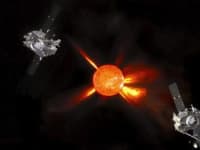The Problem:
History has seen many tragedies and disasters which can cause serious damage to spacecraft like the event of March 1991, intense solar activity took place causing satellite anomalies, power surges on power grids. This sun storm damaged the MARITIME EUROPEAN COMMUNICATION SATELLITE (MARECS)-1 completely. Hence the heat radiations emitted in the sun storm resulted in excessive temperature increase, which were not detected by the spacecraft's thermal system.
The existing method of administration of this problem is primarily through Emergency Coatings .They are usually made of plasma that are costly.
The Product:
For safety of spacecraft we introduce our product, Heat Sensors, to sense the temperature increment in spacecraft, which then can help scientists to deploy emergency thermal coatings hence preventing any damage to spacecraft material. This can be installed at different positions of spacecraft's circumference and at equal distances at the nose cone so that they can operate over the whole range of the spacecraft, hence providing better and improved results.
Our TECHNOLOGY:
This technology mainly uses RTDs (resistance temperature detectors) and a Type-K thermocouple (chromel-alumel). The material used for the RTD is fine coil of Platinum, Palladium and Gold in 31%, 55% and 14% respectively, wound over non-conductive insulating ceramic former. This coil is kept in paralyne with an inert gas in order to avoid corrosion of the coil. The temperature range of the coil is -182.9 degrees to 1400 degrees Celsius.
After the set up is done, heat sensor is connected to 16 bit microprocessor using the connecting wires with maximum temperature range of 1200 degrees which is programmed accordingly using ADRUINO SOFTWARE. This is used for A to D conversion of signals which are sent by the optical fibres made of glass fibre to the thermocouple of Type K having temperature range of -200 degrees to 1350 degrees. Feedback is involved to control temperature ramp speed and ensure actual temperature matches desired value. The LABVIEW code is developed for temperature programming and is then inserted into a prebuilt VI(Virtual Instruments) template. Various tasks are involved in LabVIEW Programs such as sampling analog signals, conversion of analog signals, feedback control algorithm, digital signal output for operating a solid state relay.
After VI template is completed, it is to be expanded so that thermocouple can be utilized and various programming modes can be realized to convert thermoelectric voltage to temperature. Then, DAQ (Data Aquisition) is inserted that controls heating switch. LED screen is installed and it's light turns on when heat resistance increases beyond threshold limit. Hence, the heat increase can be detected easily.
Cost:
As per the quotes from raw material suppliers, overall Heat Sensor costs US $2086 when completely assembled inclusive of labour costs but excluding all taxes.
Advantages:
1. It is simple and accurate.
2. It is cheaper than most of the technologies.
3. It is more reliable.
Advantages of this technology are simple but these will help this technology to be the best and accurate. This will be the major breakthrough in Space Science for the future as it will increase their safety and ensure the success of space missions.
Like this entry?
-
About the Entrant
- Name:Karunya Raj
- Type of entry:teamTeam members:Bhavika Wani (Student)
Pragya Berwal (Student)
Saloni Rastogi (Student) - Software used for this entry:Adrino software, LabVIEW software
- Patent status:none








